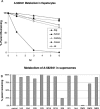Preclinical characterization of A-582941: a novel alpha7 neuronal nicotinic receptor agonist with broad spectrum cognition-enhancing properties
- PMID: 18482100
- PMCID: PMC6494002
- DOI: 10.1111/j.1527-3458.2008.00037.x
Preclinical characterization of A-582941: a novel alpha7 neuronal nicotinic receptor agonist with broad spectrum cognition-enhancing properties
Abstract
Among the diverse sets of nicotinic acetylcholine receptors (nAChRs), the alpha7 subtype is highly expressed in the hippocampus and cortex and is thought to play important roles in a variety of cognitive processes. In this review, we describe the properties of a novel biaryl diamine alpha7 nAChR agonist, A-582941. A-582941 was found to exhibit high-affinity binding and partial agonism at alpha7 nAChRs, with acceptable pharmacokinetic properties and excellent distribution to the central nervous system (CNS). In vitro and in vivo studies indicated that A-582941 activates signaling pathways known to be involved in cognitive function such as ERK1/2 and CREB phosphorylation. A-582941 enhanced cognitive performance in behavioral models that capture domains of working memory, short-term recognition memory, memory consolidation, and sensory gating deficit. A-582941 exhibited a benign secondary pharmacodynamic and tolerability profile as assessed in a battery of assays of cardiovascular, gastrointestinal, and CNS function. The studies summarized in this review collectively provide preclinical validation that alpha7 nAChR agonism offers a mechanism with potential to improve cognitive deficits associated with various neurodegenerative and psychiatric disorders.
Conflict of interest statement
All authors are employees of Abbott Laboratories, the developer of A‐582941.
Figures








References
-
- Adams J, Sweatt J (2002) Molecular psychology: Roles for the ERK MAP kinase cascade in memory. Annu Rev Pharmacol Toxicol 42: 135–163. - PubMed
-
- Adler L, Olincy A, Waldo M, Harris J, Griffith J, Stevens K, Flach K, Nagamoto H, Bickford P, Leonard S, et al (1998) Schizophrenia, sensory gating, and nicotinic receptors. Schizophr Bull 24: 189–202. - PubMed
-
- Anderson DJ, Bunnelle W, Surber B, Du J, Surowy C, Tribollet E, Marguerat A, Bertrand D, Gopalakrishnan M (2008) [3H]A‐585539 [(1S,4S)‐2,2‐dimethyl‐5‐(6‐phenylpyridazin‐3‐yl)‐5‐aza‐2‐azoniabicyclo[2.2.1] heptane], a novel high‐affinity alpha7 neuronal nicotinic receptor agonist: radioligand binding characterization to rat and human brain. J Pharmacol Exp Ther 324: 179–187. - PubMed
-
- Barik J, Wonnacott S (2006) Indirect modulation by alpha7 nicotinic acetylcholine receptors of noradrenaline release in rat hippocampal slices: Interaction with glutamate and GABA systems and effect of nicotine withdrawal. Mol Pharmacol 69: 618–628. - PubMed
Publication types
MeSH terms
Substances
LinkOut - more resources
Full Text Sources
Other Literature Sources
Miscellaneous

